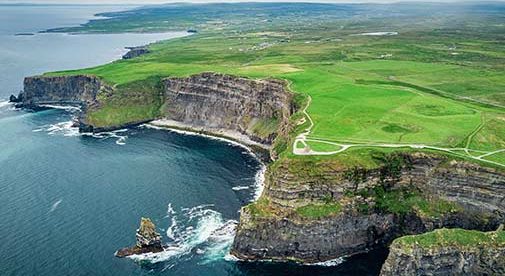Ireland. Yeats and Joyce, green hills, pubs, music, ruins, monasteries, Celtic lore. Who can resist the pull? The West Coast of Ireland, once considered the end of the known world, is the most magical part of this storied island.
[question_evergreen]
Once remote and difficult to reach, the West Coast is now much more accessible, thanks to the completion of the long-distance scenic driving route called the Wild Atlantic Way, which runs from Donegal in the north to Cork in the south. Dotted along the road are towns and villages of great beauty and historic interest. Here are three of my favorites:
Doolin

Doolin is a friendly seaside village famous for its pubs, small hotels, restaurants, and surreal landscape. Considered the traditional music capital of Ireland, it’s located on the edge of the Burren, a stony moonscape of cracked limestone called karst. Many consider the Burren a mystical place with its wealth of crosses, monastic ruins, holy wells, and megalithic tombs. And although it looks very barren and rocky, it has a temperate climate and is one of the most fertile regions in Ireland, boasting hundreds of wildflowers.
You can easily take walks right from Doolin. On a clear morning, my husband, Barry, and I walked five miles along the Coastal Trail to the Cliffs of Moher. Along the way we climbed the hill to the privately-owned 16th century Doonagore Castle for views of the ocean and the Aran Islands shimmering in the distance.
If you prefer to see the Cliffs by water, you can take a one-hour cruise from Doolin Pier or, for the adventurous, a three-hour round trip cruise to Inishmore, the largest of the Aran Islands. Guided tours of the island are available, or you can rent a bicycle and explore the raw beauty at your own pace.
Another local highlight is Doolin Cave, about two miles from the village. Its 23’ stalactite hanging down from the ceiling is the longest in the Northern hemisphere.
[ireland_signup]
Clifden

Fifty miles west of the city of Galway lies the picturesque town of Clifden, flanked by two churches and situated between the foothills of the Connemara Mountains and the Atlantic Ocean. You can easily just hang out in town, enjoying the pubs, restaurants, and shops, but Clifden also makes a perfect base for exploring the hauntingly beautiful surrounding area.
One walk, the four-mile Dooneen/Ardbear loop, starts at the Ardbear Bridge at the edge of town. This trail offers views of the Twelve Bens, the peaks within the nearby Connemara National Park that Oscar Wilde described as “a savage beauty.”
Another walk or cycle ride takes you along the newly developed Connemara Greenway, the first completed section of a longer rails-to-trails route that will ultimately link Clifden and Galway. If you rent a standard or electric bicycle at the Clifden Bike Shop, make sure to explore the romantically named (and relatively flat) Sky Road and Bog Road.
For a pleasant afternoon at a sacred site, drive 10 miles to Kylemore Abbey, a Benedictine monastery which in a previous incarnation was a 19th century castle. The monastery’s expansive grounds include a lake, tree-lined paths, six acres of Victorian walled gardens, and a Gothic church.
Just a mile out of Clifden is an important historic landmark, the landing spot where on June 15, 1919, British aviators John Alcock and Arthur Brown made the first nonstop transatlantic flight from Newfoundland. They crash-landed in the bog next to the Marconi radio station, which they had been using for navigation. They not only survived, but were knighted by King George V and awarded a £10,000 prize from the Daily Mail newspaper.
Glencolmcille

Tucked into a pocket of southwest Donegal, Glencolmcille, named for one of Ireland’s patron saints, is a small village set on the rugged Slieve League peninsula. After St. Colm Cille founded a church here in the 6th century, the area became a stronghold of early Christianity in Ireland. Gaelic is still widely spoken, and traditional music and customs remain an integral part of everyday life.
Glencolmcille would probably be a beautiful but unremarkable Irish village were it not for Father James McDyer, an enterprising parish priest in the 1960s who was deeply concerned about the steep rate of unemployment and emigration. To strengthen the local economy, he helped establish local businesses, including the Glencolmcille Folk Village, a living-history museum with clusters of cottages that show life in the village during different centuries. Also in the village is an Irish language and cultural center, Oldeas Gael, which offers weeklong classes in Gaelic, the Irish harp, fiddle, weaving, archaeology, painting, and hill-walking during the summer. For a village of only 1500 people, Glencolmcille is a happening place.
If you want to explore the surrounding area on foot, there is plenty to see, from sea cliffs and isolated beaches to deserted villages, old stone walls, megalithic tombs, quiet lanes, a ruined cottage where Dylan Thomas stayed in 1935, and the Martello Watch Tower, built during the Napoleonic era as part of a coastal defense and communications system. For details on the various routes, check out the website of the local walkers’ club, www.sliabhliagwalkers.com.
Only 10 miles from Glencolmcille are the majestic Slieve League cliffs, less famous and visited than the Cliffs of Moher but three times higher, and, at 1971 feet, the highest cliffs in Europe. You can take walks of different lengths in the area, or an archeological tour, where you’ll see watch towers, Neolithic tombs, and early Christian monastic sites.
It’s obvious, isn’t it? Wherever you stop along the Wild Atlantic Way, you just can’t go wrong. Whether you prefer drinking a beer in a lively pub while listening to local musicians perform, or standing on a cliff gazing out at the bonny blue sea, you’ll easily find your craic, or sense of fun, somewhere on the soulful west coast of Ireland.
[ireland_signup]
Related Articles
A Full Breakdown of What it Cost to Live in Ireland
[post_takeover]

